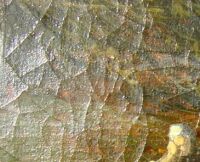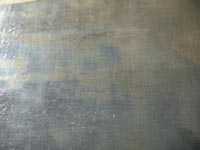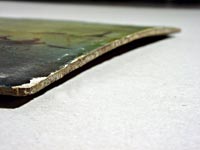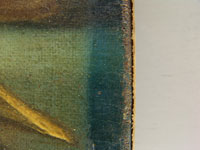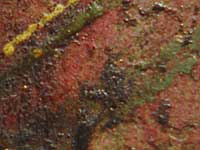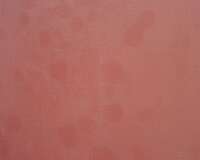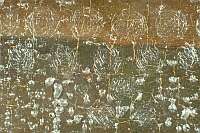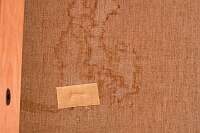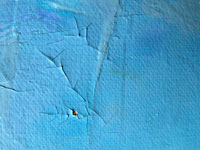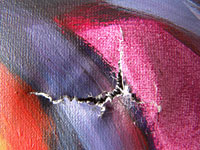
Preventive conservation
Preventive conservation is the improvement of storage conditions of art objects in order to avoid the necessity of restoration.
The storage/environmental conditions consist of all the factors around or surrounding the art object or collection. These elements should not be allowed to influence an art object or collection in a negative way.
The consequences should never be underestimated. A great deal of the damages shown on our website are the result of conditions as mentioned above.
Circumstances of storage have been widely investigated in order to reach an idea of ideal conditions of storage. It's a field of knowledge in development, with the realisation of new equipment and techniques, the increasing knowledge of materials used in art and the sharing of practical experiences. The knowledge we have of conditions of storage is increasing every year.
It is through our experience with many institutions and private collections that we know that ideal storage conditions can rarely be reached. It is possible though to make improvements after having analysed the situation.
We can offer advice on preventive conservation as to the use of equipment for air conditioning, lighting, integrated pest management, measuring light and climatological circumstances, regenerating and calibrating of measuring equipment and we reframe paintings in such a way that they are better protected.
The storage/environmental conditions consist of all the factors around or surrounding the art object or collection. These elements should not be allowed to influence an art object or collection in a negative way.
The consequences should never be underestimated. A great deal of the damages shown on our website are the result of conditions as mentioned above.
Circumstances of storage have been widely investigated in order to reach an idea of ideal conditions of storage. It's a field of knowledge in development, with the realisation of new equipment and techniques, the increasing knowledge of materials used in art and the sharing of practical experiences. The knowledge we have of conditions of storage is increasing every year.
Natural aging of objects can never be stopped, only slowed down.
Practice:
It is through our experience with many institutions and private collections that we know that ideal storage conditions can rarely be reached. It is possible though to make improvements after having analysed the situation.
We can offer advice on preventive conservation as to the use of equipment for air conditioning, lighting, integrated pest management, measuring light and climatological circumstances, regenerating and calibrating of measuring equipment and we reframe paintings in such a way that they are better protected.
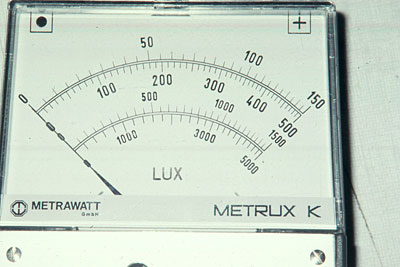
Measuring light intensity

Calibrating of thermohygrographs
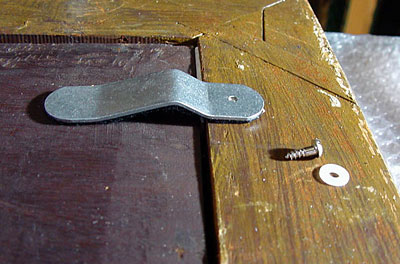
Reframing panel
A list of examples of damage to paintings caused by storage conditions:
peeling, flaked paint, cracks and cupping, damage caused by wrongly tuned climatising equipment or measuring equipment, the development of fungus, oxidation, damage by shrinkage, expansion and bending (bursting) of hygroscopic material, blue haze.
change of color - fading
scorching of the paint (e.g. by a lamp), damage caused by a relatively low level of atmospheric humidity (e.g. because of central heating), damage caused by candles burning near to the painting
fracture in the hanging system, damage to the edges of the framework, dents by dirt between frame and linen, growth of fungus and damage by dirt, breaking of a panel by too tight framework
they cause growth of fungus and oxidation (dust attracts humidity), damage by soot (from candles) and deposit of nicotine, splashes of dirt like candle-grease, wine, masonry paint, plant spray, dents caused by dirt between frame and linen

Growth of fungus on dirty paint surface
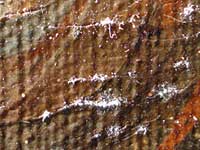
Growth of fungus from dirty paint cracks
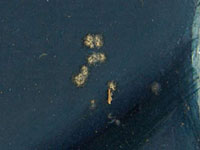
Growth of fungus on insect excrements
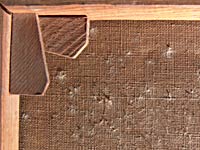
Growth of fungus at the back of linen and stretcher
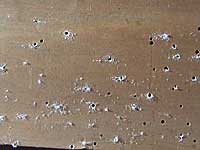
Growth of fungus from dirty woodworm holes
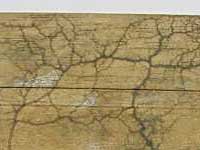
Growth of mycelium on the back of frame
damage caused by acids in wood (oak or chipboard) or cardboard, damage caused by softeners in plastics, damage caused by oxidation of materials
damage caused by shortage of space, damage because of acids or oxidation in racks or shelves, damp and water from leakages
draught, large changes in temperature and degree of humidity, bad isolation, damage by roof leakages or overflowing drainpipes, entering of dust and insects
dents caused by pine-needles between frame and linen, deformation caused by patches on the back of the linen, dents by numbers applied to the back of the linen (by auctioneers), vandalism, mechanical damages caused by bad storage or tranportation - damages caused by cleaning activities on or near the painting, peeling after cleaning with water, damages caused by cleaning attempts with halved potatoes, breadcrumbs or dusters, bad restoration

Numbers chalked by auctioneers
(on back)

Dents by chalked numbers
(on front)
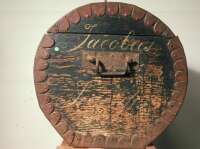
Loss of paint caused by mopping of the floor

Damage to varnish and paint, caused by fire

Vandalism (spectacles added with felt pen)
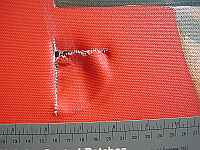
Damage caused by fall of a defect ladder
All examples mentioned above belong to the damages that occur most often, as we have assessed, but doubtlessly there will be many more.
Handling objects of art e.g. transport, storage, exposition) can cause much damage, but damage can also occur when nothing is done. Apart from preservation and restoration of art objects it is of the utmost importance to see to it that they are properly stored where environmental factors can not cause damage in such a way that they have to be treated anew.
Conservation studio
Tingietersweg 87
2031 ER Haarlem
Location/route »
Social Media



Tingietersweg 87
2031 ER Haarlem
| T. | +31 (0)23 5514993 |
| E. | info@schilderijenrestaurator.eu |
| W. | schilderijenrestaurator.eu |
Location/route »
Social Media



